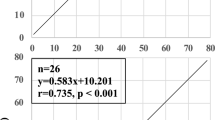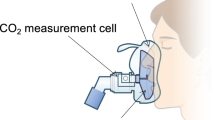Abstract
Mass spcctrometry is widely used to measure the end-tidal concentrations of inhalation anesthetics and other gases during surgery in order to estimate their arterial concentrations. When certain breathing circuits are used in newborns, however, fresh gas or ambient air may contaminate the expired sample, introducing a systematic error in the measurement of any end-tidal gas concentration. We estimated this error in newborn piglets using carbon dioxide as an indicator substance of expired gas. The capnograms and the difference between arterial carbon dioxide tension (PaCO2) and peakexpired carbon dioxide tension (PeCO2) were compared when either a coaxial (Bain) or circle breathing circuit was used. Gas was sampled from the proximal airway and distal trachea. No combination of circuit and sampling site produced a flat alveolar phase until the circle circuit was modified with diversion valves to reduce gas mixing. The mean PaCO2-PeCO2 gradients using the coaxial/proximal sampling, coaxial/distal sampling, and modified circle/proximal sampling circuits were 12.4, 9.2, and 8.8 mm Hg, respectively. The mean PeCO2 in each of these combinations was significantly different from the corresponding mean PaCO2 (p<0.05). Using the modified circle circuit with distal sampling, mean PeCO2 was not significantly different from mean PaCO2: the mean PaCO2-PcCO2 gradient was 2.2 ± 0.2 mm Hg (SEM), range, 0 to 6 mm Hg, with 95% confidence limits ⩽ 8 mm Hg. When a coaxial breathing circuit is used in small subjects, PaCO2 may be significantly underestimated regardless of sampling site, although the circle breathing circuit with distal tracheal sampling yields accurate results.
Similar content being viewed by others
References
Kaplan RF, Paulus DA: Error in sampling of exhaled gases. Anesth Analg 1983;62:956–956
Randall GCB: pH values and blood-gas tensions in the normal piglet during the first 48 hours of life. Biol Neonate 1972;20:68–73
Anonymous: CAP verifies claims for IL 813 pH/bloodgas analyzer. Pathologist 1979;33:92–93
Larson CP, Severinghaus JW: Postural variations in dead space and CO2 gradients breathing air and O2. J Appl Physiol 1962;l7:4l7–420
Askrog VF, Pender JW, Smith TC, Eckenhoff JE: Changes in respiratory dead space during halothanc, cyclopropane, and nitrous oxide anesthesia. Anesthesiology 1964;25:342–352
Reamer DB, Francis D, Philip JH, Gabel RA: Variation in PCO2 between arterial blood and peak expired gas during anesthesia. Anesth Analg 1983;62:1065–1069
Nunn JF, Hill DW: Respiratory dead space and arterial to end-tidal CO2 tension difference in anesthetized man. J Appl Physiol 1960;15:383–389
Severinghaus JW, Stupfel MA, Bradley AF: Alveolar dead space and arterial to end-tidal carbon dioxide differences during hypothermia in dog and man. J Appl Physiol 1957;10:349–355
Whitesell R, Asiddao C, Gollman D, Jablonski J: Relationship between arterial and peak expired carbon dioxide pressure during anesthesia and lactors influencing the difference. Anesth Analg 1981;60:508–5l2
Gravenstein N, Lampotang S, Beneken JEW: Factors influencing capnography in the Bain circuit. J clin Monit 1985;l:6–10
Dorsch JA, Dorsch SE: Understanding anesthesia equipment: Construction, care and complications. Baltimore: Williams and Wilkins, 1975:213
Boudreaux JP, Schieber RA, Cook DR: Hemodynamic effects of halothane in the newborn piglet. Anesth Analg 1984;63:731–737
Author information
Authors and Affiliations
Additional information
Supported in part by BRS Grant SO RR05507-20 from the Biomedical Research Support Grant Program, Division of Research Resources, National Institutes of Health, and by the American Heart Association, Lancaster, PA Chapter.
The authors thank Robert Hirsch, PhD, for his statistical advice, and Greg Harris and Perkin-Elmer, Inc for loaning the mass spectrometer.
Rights and permissions
About this article
Cite this article
Schieber, R.A., Namnoum, A., Sugden, A. et al. Accuracy of expiratory carbon dioxide measurements using the coaxial and circle breathing circuits in small subjects. J Clin Monitor Comput 1, 149–155 (1985). https://doi.org/10.1007/BF02832254
Received:
Revised:
Accepted:
Issue Date:
DOI: https://doi.org/10.1007/BF02832254




